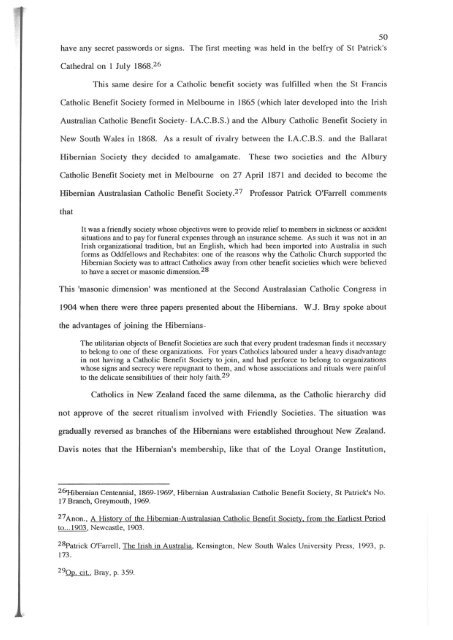TRANSPLANTED IRISH INSTITUTIONS - University of Canterbury
TRANSPLANTED IRISH INSTITUTIONS - University of Canterbury
TRANSPLANTED IRISH INSTITUTIONS - University of Canterbury
Create successful ePaper yourself
Turn your PDF publications into a flip-book with our unique Google optimized e-Paper software.
50<br />
have any secret passwords or signs. The first meeting was held in the belfry <strong>of</strong> St Patrick's<br />
Cathedral on 1 July 1868. 26<br />
This same desire for a Catholic benefit society was fulfilled when the St Francis<br />
Catholic Benefit Society formed in Melbourne in 1865 (which later developed into the Irish<br />
Australian Catholic Benefit Society- l.A.C.B.S.) and the Albury Catholic Benefit Society in<br />
New South Wales in 1868. As a result <strong>of</strong> rivalry between the l.A.C.B.S. and the Ballarat<br />
Hibernian Society they decided to amalgamate.<br />
These two societies and the Albury<br />
Catholic Benefit Society met in Melbourne on 27 April 1871 and decided to become the<br />
Hibernian Australasian Catholic Benefit Society.27 Pr<strong>of</strong>essor Patrick O'Farrell comments<br />
that<br />
It was a friendly society whose objectives were to provide relief to members in sickness or accident<br />
situations and to pay for funeral expenses through an insurance scheme. As such it was not in an<br />
Irish organizational tradition, but an English, which had been imported into Australia in such<br />
forms as Oddfellows and Rechabites: one <strong>of</strong> the reasons why the Catholic Church supported the<br />
Hibernian Society was to attract Catholics away from other benefit societies which were believed<br />
to have a secret or masonic dimension. 28<br />
This 'masonic dimension' was mentioned at the Second Australasian Catholic Congress in<br />
1904 when there were three papers presented about the Hibernians. W.J. Bray spoke about<br />
the advantages <strong>of</strong> joining the Hibernians-<br />
The utilitarian objects <strong>of</strong> Benefit Societies are such that every prudent tradesman finds it necessary<br />
to belong to one <strong>of</strong> these organizations. For years Catholics laboured under a heavy disadvantage<br />
in not having a Catholic Benefit Society to join, and had perforce to belong to organizations<br />
whose signs and secrecy were repugnant to them, and whose associations and rituals were painful<br />
to the delicate sensibilities <strong>of</strong> their holy faith.29<br />
Catholics in New Zealand faced the same dilemma, as the Catholic hierarchy did<br />
not approve <strong>of</strong> the secret ritualism involved with Friendly Societies. The situation was<br />
gradually reversed as branches <strong>of</strong> the Hibernians were established throughout New Zealand.<br />
Davis notes that the Hibernian's membership, like that <strong>of</strong> the Loyal Orange Institution,<br />
26tJ.iibernian Centennial, 1869-1969', Hibernian Australasian Catholic Benefit Society, St Patrick's No.<br />
17 Branch, Greymouth, 1969.<br />
27 Anon., A History <strong>of</strong> the Hibernian-Australasian Catholic Benefit Society. from the Earliest Period<br />
to ... 1903, Newcastle, 1903.<br />
28Patrick O'Farrell, The Irish in Australia, Kensington, New South Wales <strong>University</strong> Press, 1993, p.<br />
173.<br />
290p. cit., Bray, p. 359.
















